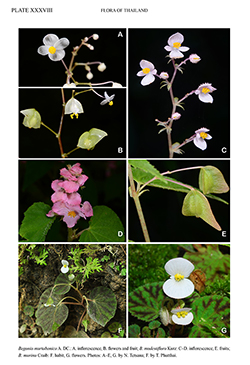e-Flora of Thailand
Volume 14 > Part 3 > Year 2019 > Page 401 > Begoniaceae > Begonia
31. Begonia murina Craibwfo-0000824887
[§ Diploclinium], Gard. Chon., III 83: 66. 1928; Craib, Fl. Siam. 1: 776. 1931; Hughes, Annot. Checkl. SE Asian Begonia. 88. 2008. Plate XXXVIII: F–G.
Accepted Name : This is currently accepted.
Synonyms & Citations :
Description : Monoecious caulescent herb, 10–25 cm tall. Stems succulent, erect or suberect, densely hairy, dark red; tubers globose or subglobose with numerous fibrous roots, ca 4−10 mm diam. Leaves only 2−4(−5) per plant; petiole dark red, reddish brown when dry, densely pilose, 1.5−10(−15) cm long; lamina basifixed, succulent, symmetric or subsymmetric, chartaceous when dry, adaxial surface densely pilose, light or dark green or dark green with black or reddish brown variegated patches on veins, abaxial surface densely pilose, pale green or dark red on veins, ovate or orbicular, 2−11 by 3−10 cm, base cordate, apex rounded, margin crenate, ciliate, venation palmate, veins 5−7. Stipules persistent, dark red, lanceolate, 2−3 by 0.5−1 mm, hairy, apex acute, margin ciliate. Inflorescences terminal, cymose, bisexual, branched 1−2 times, 3−6 cm long, with 3−4 staminate flowers and 1 pistillate flower per branch, protandrous; peduncles whitish pink, 3−6 cm long, terete, densely pilose. Bracts caducous, membranous, pale green, lanceolate, 2−3 by 1 mm, densely pilose, apex obtuse, margin entire. Staminate flowers: pedicels whitish pink, 10−30 mm long, erect; tepals 4, plain white, outer 2 orbicular or obovate, 10−12 by 8−10 mm, base obtuse or cuneate, apex rounded, margin entire, outer parts densely pilose, inner parts glabrous, inner tepals absent or 2 narrowly oblong, 4−5 by 2 mm, base obtuse, apex obtuse, margin entire, glabrous on both sides; androecium actinomorphic, subglobose, stamens numerous, yellow, filaments ca 1 mm long, fused at base, anthers obovate ca 1 mm long, dehiscing by longitudinal slits. Pistillate flowers: pedicels greenish white, 10−20 mm long; tepals 2, plain white, ovate or orbicular, 8−10 by 9−10 mm, base obtuse, apex obtuse, margin entire, outer part densely pilose; styles 3, fused at base, twice spirally twisted, dark yellow, stigmatic band crescent-shaped; ovary green with red striation, 3 subequal wings, densely pilose, 3-locular, placentae bilamellate. Fruit a dehiscent capsule, pale green with red striation, drying pale brown, 10−12 by 10 mm; locules elliptic, 3 by 8 mm, wings 3, subequal, triangular, ca 5 mm long. Seeds brown, barrel-shaped, 0.3−0.4 mm.
Thailand : NORTHERN: Sukhothai; SOUTH-WESTERN: Kanchanaburi (Ratchaburi – type: Kerr s.n. [cultivated], syntypes -ABD).
Distribution : Endemic.
Ecology : In limestone rock crevices by streamsides in dry evergreen forests, 100–300 m alt. Flowering: May–November; fruiting: November–December.
Vernacular : Dat hin (ดาดหิน).
Notes: This endemic species is restricted to limestone and is distributed along the limestone outcrops that begin in the north, then through Kanchanaburi, and into the south western and peninsular regions. Craib (1931) distinguished Begonia notata from B. murina on account of it being sparsely glabrous or glabrous but we regard this as within-species variation.

